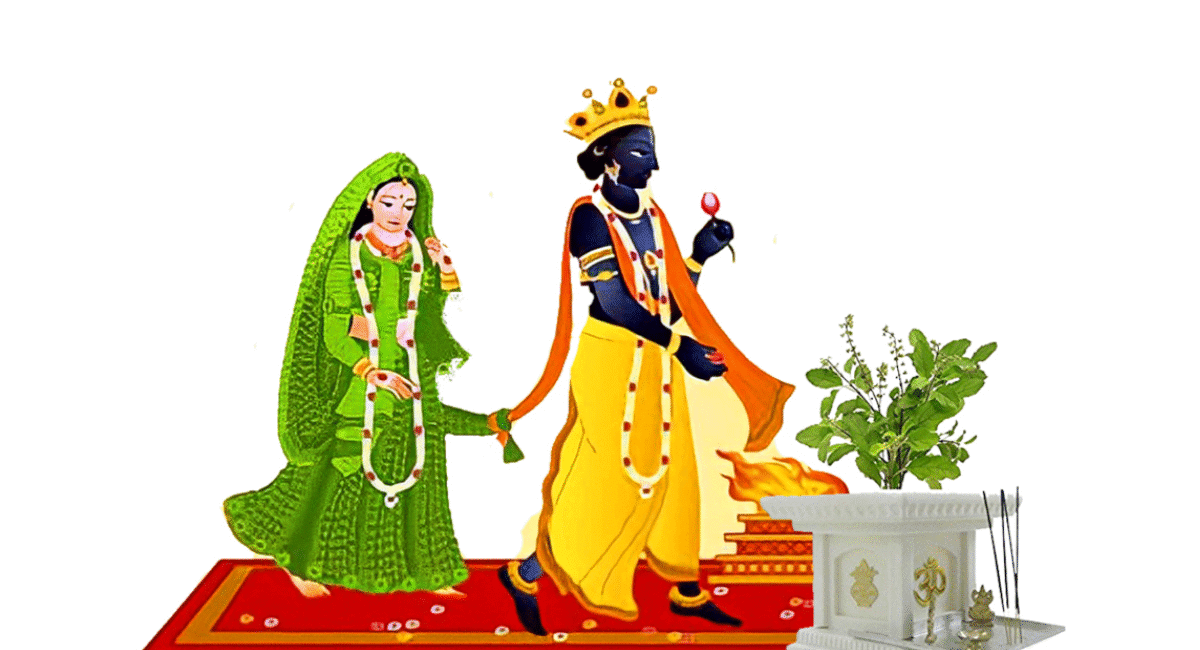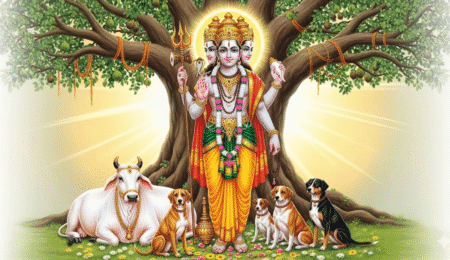Why We Perform Tulsi Vivah? History & Rituals
Why We Perform Tulsi Vivah?
In the heart of every Hindu home, the Tulsi plant stands as a living symbol of purity, devotion, and divine presence. But once a year, this humble plant transforms into a radiant bride. Tulsi Vivah, the ceremonial marriage of Tulsi Devi and Lord Vishnu, is not just a ritual it’s a celebration of cosmic love, spiritual redemption, and the triumph of dharma.
As the Kartik month unfolds, homes are swept clean, courtyards are decorated, and families gather to witness a wedding unlike any other. The bride is a plant, the groom a sacred stone, and the blessings—immeasurable. This ritual, steeped in mythology and emotion, marks the beginning of the Hindu wedding season and reminds us that even the smallest leaf can carry the weight of divine promise.
What Is Tulsi Vivah?
Tulsi Vivah is the symbolic wedding of the Tulsi plant (Holy Basil) with Lord Vishnu, typically represented by a Shaligram (a sacred fossil stone). It is celebrated on Kartik Shukla Dwadashi, the twelfth day of the bright fortnight in the Kartik month, usually falling in October or November.
- Tulsi Vivah 2025 Date: November 2, 2025
- Muhurat: Begins at 7:31 AM on Nov 2 and ends at 5:07 AM on Nov 3
This day marks the end of Chaturmas, the four-month period when Lord Vishnu is believed to be asleep. With his awakening on Dev Uthani Ekadashi, Tulsi Vivah follows as the first auspicious event of the season.
History and Mythology Behind Tulsi Vivah
The Tale of Vrinda and Jalandhar
The origins of Tulsi Vivah lie in the poignant story of Vrinda, a devoted wife and ardent devotee of Lord Vishnu. She was married to Jalandhar, a powerful demon whose strength stemmed from Vrinda’s chastity and devotion.
To protect the universe from Jalandhar’s tyranny, Lord Vishnu took the form of Jalandhar and deceived Vrinda, breaking her purity. This led to Jalandhar’s defeat, but Vrinda, devastated by the betrayal, cursed Vishnu to become a stone and immolated herself. From her ashes, the Tulsi plant was born.
Moved by her unwavering devotion, Vishnu promised to marry her in his Shaligram form, thus giving rise to the tradition of Tulsi Vivah.
Symbolism of the Myth
- Vrinda’s sacrifice represents the triumph of dharma over adharma
- Tulsi’s transformation into a sacred plant symbolizes purity and resilience
- Vishnu’s promise reflects divine compassion and the sanctity of devotion
Why Hindus Perform Tulsi Vivah
Tulsi Vivah is performed for both spiritual merit and social significance. Here’s why it holds such deep meaning:
Spiritual Reasons
- To honor Vrinda’s devotion and Vishnu’s divine promise
- To purify the home and invite divine blessings
- To mark the beginning of auspicious events, especially weddings
- To perform Kanyadaan symbolically for those without daughters
- To seek marital harmony, prosperity, and protection from negative energies
Social and Cultural Reasons
- Brings families together in a shared spiritual experience
- Reinforces traditional values and storytelling
- Encourages eco-conscious rituals using natural elements
- Offers a way for children to learn and participate in dharmic practices
Step-by-Step Tulsi Vivah Rituals & Preparations
Preparations Before the Ceremony
- Clean the home and courtyard thoroughly
- Set up a mandap using sugarcane, banana stalks, or bamboo
- Place the Tulsi plant in the center, elevated on a platform
- Keep a Shaligram or Vishnu idol beside Tulsi
Dressing Tulsi as a Bride
- Wrap Tulsi in a red or yellow sari
- Apply haldi (turmeric), kumkum, and sandalwood paste
- Decorate with flowers, bangles, and a red chunari
- Place a mangalsutra and toe rings if available
The Wedding Ceremony
- Tie a cotton thread (mala) between Tulsi and Shaligram
- Offer rice, sweets, fruits, and suhaag items
- Recite Vishnu Sahasranama or Tulsi Stotra
- Perform aarti and sing bhajans
- Distribute prasadam to guests and family
Observing the Vrat
- Women often observe a fast (vrat) until the evening
- The ritual is performed during the auspicious muhurat
- Some families conduct a puja with a priest, while others do it informally
Tulsi Vivah Significance in Modern Times
In today’s digital age, Tulsi Vivah continues to resonate deeply:
Spiritual Relevance
- Encourages daily worship and connection with nature
- Reinforces values of sacrifice, purity, and devotion
- Offers a pause from materialism, inviting introspection
Emotional and Mental Benefits
- Creates a sense of belonging and continuity
- Provides emotional healing through ritual and prayer
- Strengthens family bonds through shared celebration
Eco-Conscious Rituals
- Promotes sustainable practices using natural decorations
- Avoids synthetic materials, aligning with environmental dharma
Regional Traditions Across India
Maharashtra
- Tulsi Vivah is celebrated with sugarcane mandaps, turmeric lamps, and folk songs
- Women offer suhaag items and perform aarti with devotion
- Often includes community gatherings and shared meals
Gujarat
- Known for colorful Tulsi decorations with mirror-work and embroidery
- Rituals include Garba, bhajans, and storytelling
- Tulsi is worshipped as a manifestation of Lakshmi
South India
- Tulsi is revered as Lakshmi Devi, and rituals are temple-centric
- Includes chanting of Vishnu Sahasranama, offering of Pongal and fruits
- Often performed by priests in traditional attire
Each region adds its own flavor, language, and devotional style, enriching the pan-Indian tapestry of Tulsi Vivah.
Spiritual and Social Importance
Tulsi Vivah is a multi-dimensional ritual that touches every aspect of life:
Spiritual Impact
- Invokes divine blessings for health, wealth, and harmony
- Strengthens personal sadhana and bhakti
- Purifies the home and mind
Social Relevance
- Encourages intergenerational participation
- Preserves oral traditions and mythology
- Builds community spirit through shared rituals
It’s a gentle reminder that faith is not just in temples, but in the soil, leaves, and stories we nurture at home.
FAQs About Tulsi Vivah
1. What is the Tulsi Vivah 2025 date and muhurat?
Tulsi Vivah 2025 falls on November 2, with the auspicious muhurat from 7:31 AM to 5:07 AM on November 3.
2. Why do we perform Tulsi Vivah?
To honor the divine union of Tulsi and Vishnu, seek blessings for prosperity, and mark the start of the Hindu wedding season.
3. Can Tulsi Vivah be performed at home?
Yes. Many families perform Tulsi Vivah in their courtyards or balconies with simple rituals and heartfelt devotion.
4. Is fasting necessary for Tulsi Vivah?
While not mandatory, many women observe a vrat for spiritual merit and blessings.
5. What items are needed for Tulsi Vivah rituals?
Tulsi plant, Shaligram/Vishnu idol, red/yellow cloth, kumkum, turmeric, flowers, sweets, suhaag items, and aarti thali.
6. What is the mythological story behind Tulsi Vivah?
It’s the story of Vrinda, her sacrifice, and Vishnu’s promise to marry her in his Shaligram form.
7. Is Tulsi Vivah relevant in modern times?
Absolutely. It fosters spiritual connection, eco-awareness, and cultural continuity in today’s world.
How to Make Tulsi Vivah More Meaningful Today
Incorporating Tulsi Vivah into modern life can be both spiritually enriching and culturally empowering. Here are some actionable ways to deepen the experience:
Eco-Friendly Rituals
- Use biodegradable decorations like banana leaves, turmeric lamps, and clay diyas
- Avoid plastic flowers or synthetic fabrics
- Compost offerings respectfully after the ritual
Digital Devotion
- Share the story of Tulsi Vivah on social media to educate others
- Host virtual Tulsi Vivah gatherings for family members living afar
- Create short reels or blog posts explaining the ritual’s significance
Involving Children
- Let children help decorate the mandap and dress Tulsi
- Narrate the story of Vrinda and Vishnu in simple language
- Encourage them to sing bhajans or recite mantras
Home Sanctity
- Place the Tulsi plant in a clean, sunlit spot and water it daily
- Offer a small prayer each morning to maintain spiritual continuity
- Use Tulsi leaves in cooking with reverence, not casually
These practices ensure that Tulsi Vivah is not just a one-day event but a living tradition that nurtures the soul year-round.
Conclusion: A Divine Promise Fulfilled
Tulsi Vivah is more than a ritual it’s a celebration of divine love, sacrifice, and spiritual renewal. In the story of Vrinda, we find unwavering devotion. In Vishnu’s promise, we find compassion. And in the Tulsi plant, we find a living goddess who blesses our homes with purity and grace.
As you prepare for Tulsi Vivah 2025, may your heart be as open as the petals of Tulsi, and your home as radiant as the Kartik moon. Let this sacred union remind us that faith is not just in temples, but in the soil we nurture, the stories we tell, and the rituals we lovingly preserve.
Performing Tulsi Vivah is not just about tradition it’s about participating in a cosmic love story, one that continues to inspire generations. So dress Tulsi Mata with devotion, sing her praises, and let the divine wedding bring joy, harmony, and blessings into your life.




Leave a Comment